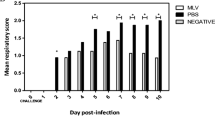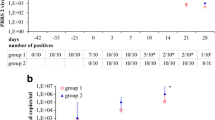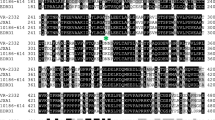Abstract
Recently, the Chinese highly pathogenic porcine reproductive and respiratory syndrome virus (PRRSV) (HP-PRRSV) belonging to lineage 8 causes severe symptom with high morbidity and high mortality rates to the Asian pig industry. A recent study showed that pigs immunized with Fostera® PRRS modified live virus (MLV) of lineage 8 could provide a degree of protection against a Vietnamese HP-PRRSV infection. It should be noted that PRRSV commonly found after weaning causes porcine respiratory disease complex (PRDC). Vaccination strategy should be evaluated in each farm scenario. Eighty-one PRRSV-free piglets obtained from a PRRS-free herd were divided into two experiments with the major difference of infection timing after vaccination, 42 days in experiment 1 (n = 42) and 28 days in experiment 2 (n = 39). Each experiment had similar protocol containing three groups including a negative control, unvaccinated challenged, and vaccinated challenged groups. Pigs in vaccination groups were immunized with Fostera® PRRS MLV vaccine at 3 weeks of age. Then, unvaccinated challenged and vaccinated challenged groups were intranasally inoculated with a Thai HP-PRRSV (10PL01). Vaccinated challenged pigs showed significantly lower levels of mean rectal temperatures, clinical severity, lung lesion scores, and viral titers in serum and lung tissue compared to the unvaccinated challenged pigs (p < 0.05). Vaccinated challenged pigs had higher survival rate than those of unvaccinated challenged pigs in both experiments. It should be noted that pigs challenged 42 days after vaccination showed a better performance than pigs challenged 28 days after vaccination. In conclusion, Fostera® PRRS MLV vaccine was able to improve the survival rate against the Thai HP-PRRSV infection in both 42- and 28-day vaccination-to-infection protocols.









Similar content being viewed by others
References
Conzelmann, K.-K., Visser, N., Van Woensel, P., and Thiel, H.-J., 1993. Molecular characterization of porcine reproductive and respiratory syndrome virus, a member of the arterivirus group, Virology, 193, 329–339.
Darwich, L., Díaz, I., and Mateu, E., 2010. Certainties, doubts and hypotheses in porcine reproductive and respiratory syndrome virus immunobiology, Virus Research, 154, 123–132.
Do, D.T., Park, C., Choi, K., Jeong, J., Nguyen, T.T., Nguyen, K.D., and Chae, C., 2015. Comparison of two genetically distant type 2 porcine reproductive and respiratory syndrome virus (PRRSV) modified live vaccines against Vietnamese highly pathogenic PRRSV, Veterinary Microbiology, 179, 233–241.
Egli, C., Thür, B., Liu, L., and Hofmann, M.A., 2001. Quantitative TaqMan® RT-PCR for the detection and differentiation of European and North American strains of porcine reproductive and respiratory syndrome virus, Journal of Virological Methods, 98, 63–75.
Halbur, P., Paul, P., Frey, M., Landgraf, J., Eernisse, K., Meng, X.-J., Lum, M., Andrews, J., and Rathje, J., 1995. Comparison of the pathogenicity of two US porcine reproductive and respiratory syndrome virus isolates with that of the Lelystad virus, Veterinary Pathology, 32, 648–660.
Han, K., Seo, H., Oh, Y., Kang, I., Park, C., and Chae, C., 2013. Comparison of the virulence of European and North American genotypes of porcine reproductive and respiratory syndrome virus in experimentally infected pigs, The Veterinary Journal, 195, 313–318.
Jantafong, T., Sangtong, P., Saenglub, W., Mungkundar, C., Romlamduan, N., Lekchareonsuk, C., and Lekcharoensuk, P., 2015. Genetic diversity of porcine reproductive and respiratory syndrome virus in Thailand and Southeast Asia from 2008 to 2013, Veterinary Microbiology, 176, 229–238.
Johnson, W., Roof, M., Vaughn, E., Christopher-Hennings, J., Johnson, C.R., and Murtaugh, M.P., 2004. Pathogenic and humoral immune responses to porcine reproductive and respiratory syndrome virus (PRRSV) are related to viral load in acute infection, Veterinary Immunology and Immunopathology, 102, 233–247.
Klinge, K.L., Vaughn, E.M., Roof, M.B., Bautista, E.M., and Murtaugh, M.P., 2009. Age-dependent resistance to Porcine reproductive and respiratory syndrome virus replication in swine, Virology Journal, 6, 1.
Laohasittikul, P., Boonarpha, N., Pongprapachuen, Y., Kesdangsakonwut, S., Wangnaitham, S., and Thanawongnuwech, R., 2004. Antigen distribution of porcine reproductive and respiratory syndrome virus (PRRSV) in Thai crossbred pigs using immunohistochemistry, Thai Journal of Veterinary Medicine. 34, 39–48.
Li, X., Galliher-Beckley, A., Pappan, L., Trible, B., Kerrigan, M., Beck, A., Hesse, R., Blecha, F., Nietfeld, J.C., and Rowland, R., 2014. Comparison of host immune responses to homologous and heterologous type II porcine reproductive and respiratory syndrome virus (PRRSV) challenge in vaccinated and unvaccinated pigs, BioMed Research International, doi: 10.1155/2014/416727.
Lohse, L., Nielsen, J., and Eriksen, L., 2004. Temporary CD8+ T-cell depletion in pigs does not exacerbate infection with porcine reproductive and respiratory syndrome virus (PRRSV), Viral Immunology, 17, 594–603.
Meier, W.A., Galeota, J., Osorio, F.A., Husmann, R.J., Schnitzlein, W.M., and Zuckermann, F.A., 2003. Gradual development of the interferon-γ response of swine to porcine reproductive and respiratory syndrome virus infection or vaccination, Virology, 309, 18–31.
Meng, X., 2000. Heterogeneity of porcine reproductive and respiratory syndrome virus: implications for current vaccine efficacy and future vaccine development, Veterinary Microbiology, 74, 309–329.
Mengeling, W.L., Lager, K.M., Vorwald, A.C., and Koehler, K.J., 2003. Strain specificity of the immune response of pigs following vaccination with various strains of porcine reproductive and respiratory syndrome virus, Veterinary Microbiology, 93, 13–24.
Meulenberg, J.J., Hulst, M.M., de Meijer, E.J., Moonen, P.L., den Besten, A., de Kluyver, E.P., Wensvoort, G., and Moormann, R.J., 1993. Lelystad virus, the causative agent of porcine epidemic abortion and respiratory syndrome (PEARS), is related to LDV and EAV, Virology, 192, 62–72.
Na Ayudhya, S.N., Assavacheep, P., and Thanawongnuwech, R., 2012. One World–One Health: the threat of emerging swine diseases. an Asian perspective, Transboundary and Emerging Diseases, 59, 9–17.
Nielsen, J., and Bøtner, A., 1997. Hematological and immunological parameters of 412-month old pigs infected with PRRS virus, Veterinary Microbiology, 55, 289–294.
Nilubol, D., Tripipat, T., Hoonsuwan, T., and Kortheerakul, K., 2012. Porcine reproductive and respiratory syndrome virus, Thailand, 2010–2011, Emerging Infectious Diseases, 18, 2039–2043.
Park, C., Seo, H.W., Han, K., Kang, I., and Chae, C., 2014. Evaluation of the efficacy of a new modified live porcine reproductive and respiratory syndrome virus (PRRSV) vaccine (Fostera PRRS) against heterologous PRRSV challenge, Veterinary Microbiology, 172, 432–442.
Rossow, K.D., Bautista, E.M., Goyal, S.M., Molitor, T.W., Murtaugh, M.P., Morrison, R.B., Benfield, D.A., and Collins, J.E., 1994. Experimental porcine reproductive and respiratory syndrome virus infection in one-, four-, and 10-week-old pigs, Journal of Veterinary Diagnostic Investigation, 6, 3–12.
Shi, M., Lam, T.T.-Y., Hon, C.-C., Murtaugh, M.P., Davies, P.R., Hui, R.K.-H., Li, J., Wong, L.T.-W., Yip, C.-W., and Jiang, J.-W., 2010. Phylogeny-based evolutionary, demographical, and geographical dissection of North American type 2 porcine reproductive and respiratory syndrome viruses, Journal of Virology, 84, 8700–8711.
Thanawongnuwech, R., Thacker, E.L., and Halbur, P.G., 1998. Influence of pig age on virus titer and bactericidal activity of porcine reproductive and respiratory syndrome virus (PRRSV)-infected pulmonary intravascular macrophages (PIMs), Veterinary Microbiology, 63, 177–187.
Tian, K., Yu, X., Zhao, T., Feng, Y., Cao, Z., Wang, C., Hu, Y., Chen, X., Hu, D., and Tian, X., 2007. Emergence of fatal PRRSV variants: unparalleled outbreaks of atypical PRRS in China and molecular dissection of the unique hallmark, PLoS One, 2, e526.
Van der Linden, I., Voermans, J., Van der Linde-Bril, E., Bianchi, A., and Steverink, P., 2003. Virological kinetics and immunological responses to a porcine reproductive and respiratory syndrome virus infection of pigs at different ages, Vaccine, 21, 1952–1957.
Wu, W.-H., Fang, Y., Farwell, R., Steffen-Bien, M., Rowland, R.R., Christopher-Hennings, J., and Nelson, E.A., 2001. A 10-kDa structural protein of porcine reproductive and respiratory syndrome virus encoded by ORF2b, Virology, 287, 183–191.
Zuckermann, F., and Husmann, R., 1996. Functional and phenotypic analysis of porcine peripheral blood CD4/CD8 double-positive T cells, Immunology, 87, 500.
Acknowledgments
This study was financially supported by the 72nd Birthday Anniversary of His Majesty the King’s Scholarship to a Master degree student of the Department of Pathology, Faculty of Veterinary Science, Chulalongkorn University (Mr. Ponlakrit Charoenchanikran, GCUGE12-1), National Research University Project, Office of Higher Education Commission (NRU-59-PPS023-HR), The Thailand Research Fund (TRF) for TRF senior scholar for Alongkorn Amonsin (RTA5700085), and Zoetis (Thailand) Limited study number B826R-TH-13-249.
Author information
Authors and Affiliations
Corresponding authors
Ethics declarations
Conflict of interest
The authors declare that they have no conflict of interest.
Rights and permissions
About this article
Cite this article
Charoenchanikran, P., Kedkovid, R., Sirisereewan, C. et al. Efficacy of Fostera® PRRS modified live virus (MLV) vaccination strategy against a Thai highly pathogenic porcine reproductive and respiratory syndrome virus (HP-PRRSV) infection. Trop Anim Health Prod 48, 1351–1359 (2016). https://doi.org/10.1007/s11250-016-1099-1
Received:
Accepted:
Published:
Issue Date:
DOI: https://doi.org/10.1007/s11250-016-1099-1




